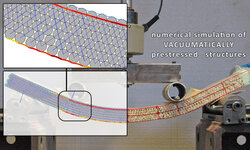Numerical simulation of vacuumatically prestressed structures
Vacuumatics can be regarded as an assembly of (granular) material enclosed by a membrane skin, of which the structural integrity is dependent on the absence of (internal) air, or rather the existence of an underpressure. A vacuum coffee pack is the best known example for vacuumatics as a rigid square block you can buy in a super market. When the enclosing membrane is punctured, the internal negative pressure disappears and the coffee filling becomes loose granulate. Interesting quality of vacuumatics is that when the size of the internal pressure is controlled, the system can become mouldable like clay, after which the shape can be fixated by increasing the level of underpressure. This leads to the potentially effective application as an adaptable structure, for instance as ‘flexible’ formwork for the realisation of complex shaped concrete structures. In order to research the feasibility of vacuumatics for certain applications, it is necessary to investigate the structural behaviour of vacuumatics and its relation to the properties of the filler material ('grains') and the membrane skin.
Analytical research has demonstrated that the atmospheric pressure referred to as ‘vacuum pressure’ acting on the membrane skin can be simulated by means of a so-called direct and an indirect prestress force acting on each individual filler particle. The direct prestressing component is determined by the part of the skin that covers a filler particle and therefore directly transforms the atmospheric pressure into a prestress force. The tension in the membrane that is developed due to the voids in between two adjacent filler particles is responsible for an indirect prestress force. The modulus of elasticity of the membrane has a key role in the development of both the prestressing components. In addition to this analytical research, earlier experimental studies and an ongoing PhD research at this university (TU/e) have shown the influence of material characteristics of the filler particles and membrane on the flexural rigidity of vacuumatics. There is however no possibility for insight into internal forces that arise during the experiments as tension sensors would influence the results as well.
The subject for this graduation project was to determine the relation between the material characteristics (of the filler grains and membrane envelope) that determine the flexural rigidity of a vacuumatic structure. The goal for this graduation project was thus to set-up a numerical research that enables us to investigate the internal forces of vacuumatic structures under vacuumatics prestressing as well as during external loading.
The granular characteristic of the filler material of vacuumatics results in a nearly infinite number of contact problems and thus the requirement for a Discrete Element Method (DEM) to simulate vacuumatic structures. Standard boundary conditions for DEM however are rigid borders or periodic boundaries (simulating infinite space) and not able to simulate the flexible membrane skin. Therefore new modules are developed into the software used, called HADES, in cooperation with the developer Dynaflow. The first part of the graduation project focuses on this aspect, the simulation of the membrane skin in DEM, for which two approaches are developed.
The first method uses an analytical approach referred to as the 'Atmospheric Pressure Model'. This model determines which grains of the assembly are likely to be covered with the skin and subsequently applies forces on each of these (edge) grains, hence simulating the skin analytically (and thus not physically). The size, location and direction of these forces are based on the values determined by the analytical research. Although this method can successfully simulate a prestressed vacuumatic beam, it has some important limitations among which the inability to adjust the skin envelope in accordance with changes in particle configuration during the simulation of a vacuumatics-beam subjected to (external) bending loads and the effects of friction between skin and grains.
Given the insurmountable problems with the analytical approach of the skin simulation, a new method is developed that simulates the skin ‘physically’ with a so called 'Membrane Model'. This method, referred to as the Bead Chain Method (BCM), simulates the membrane skin as a series of interconnected (small) membrane particles, or ‘beads’, each with a mass that represents the corresponding piece of the skin. The interconnections between the beads – representing the skin between two mass points – simulate the mechanical behaviour of the skin. The vacuum pressure that acts on the skin is transferred to forces on the mass particles, based on the pieces of skin (interconnections) that it represents. With common Hertz contact models, the relation of the membrane (beads) with the filler grains can be described including friction effects. Bench mark tests have shown that this method can accurately and reliably describe the characteristics of the membrane and its relation with the filler grains.
Using the BCM, full scale 2-dimensional four-point bending tests were simulated corresponding to the dimensions of real-time experimental research. A parameter study is performed, of which the force-displacement graphs show similar trends as those of the experimental research. Using a MATLAB script, the output data, consisting of element states and contact forces, is plotted which gives insight of the internal forces in the vacuumatics beam at any given timestep. The force displacement graphs in combination with plots of the internal forces at key points are used to analyse the influence of various material characteristics. The conclusions of this analysis is that the packing density and elasticity modulus of the filler grains are the main aspects for the initial flexural rigidity of vacuumatic structures. As the forces and deformations increase, the friction between filler grains and the membrane elasticity are decisive for the residual capacity.
Student : R.A. Smittenaar (Ruben)
Committee: dr.ir. H. Hofmeyer / ir. G. Lindner / ir.arch. F.A.A. Huijben
Graduation date: 28 august 2012
